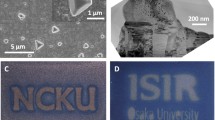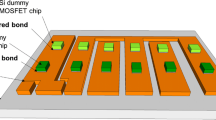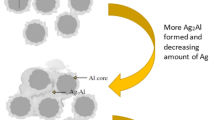Abstract
Silver and palladium/silver compositions are widely used in hybrid microelectronics, as electrodes for dielectric layers and multilayers, terminations of thick film resistors and interconnections. Interactions between Ag and the adjacent films are known to affect the microcircuit performances. The present study is aimed at collecting data on the behavior of Ag-based films in contact with glassy layers. Most experiments were performed with a glass with composition 68.2 PbO : 30.5 SiO2 : 1.3 Al2O3 wt %. Two different systems were analyzed. The first system consists of thick films prepared from a paste containing glass and either 3 or 15 wt % silver particles; both fine (spherical grains, 0.5–1 μm diameter) and coarse (flakes, 2–5 μm, <1 μm thick) Ag powders were used for these pastes. The distribution of Ag in the film was studied with X-ray diffraction, scanning electron microscopy and fluorescence analysis. The results show that Ag floats on the glassy layer. Diffraction of X-rays generated by a synchrotron radiation source allowed us to study the kinetics of silver dissolution in the glass; this phenomenon is consistent with the Avrami theory, with an apparent activation energy E dis=0.69±0.04 eV. The second system analyzed, Ag-based terminations of glass layers fired at various peak temperatures, enabled us to obtain quantitative values for both Ag solid solubility (about 2.5 wt %) and Ag diffusion coefficients D Ag(T ). Typical values of D Ag(850 °C) are 30.3±11.9 10−8 cm2/s; an apparent activation energy of the diffusion process is E a=0.6±0.1 eV.
Similar content being viewed by others
References
M. Prudenziati (ed.)Thick Film Sensors’ (Elsevier, Amsterdam, 1994).
J. J. Licari and L. R. EnlowHybrid Microcircuit Technology Handbook’ (Noye Public, Park ridge, NJ, 1988).
A. Cattaneo, M. Cocito, F. Forlani and M. Prudenziati, Electro-Comp. Sci. Technol. 4 (1977) 205.
M. Prudenziati, B. Morten, G. Ruffi, E. Argentino and C. Iachetti, in Proceedings to the 7th Europep. Hybrid Microel. Conference, Hamburg, FRG, May 1989, 4.5.
M. Prudenziati, B. Morten and A. Taroni, Int. J. Hybrid Microel. 4 (1981) 341.
M. Prudenziati, F. Sirotti, M. Sacchi, B. Morten, A. Tombesi and T. Akomolafe, Active Passive Elec. Comp. 14 (1991) 163.
K. Yata and T. Yamaguchi, J. Amer. Ceram. Soc. 75 (1992) 2071.
M. Prudenziati, B. Morten, L. Moro, L. Olumekor and A. Tombesi, J. Phys. D: Appl. Phys. 19 (1986) 275.
B. Forti, A. F. Gualtieri, M. Leoni, M. Prudenziati and C. C. Tang, in Materials Science Forum, Proceedings of the EPDC 1998, Budapest, 22–25 August 1998.
C. H. Bamford and C. F. H. TipperComprehensive Chemical Kinetics’, vol. 22 (Elsevier, New York, 1980).
J. ZarzyskiGlasses and the Vitreous State’ (Cambridge University Press, Cambridge, MA, 1991).
W. A. WeylColoured Glasses’ (Society of Glass Technology, Sheffield, England, 1951).
C. PantanoExperimental Techniques of glass science’, edited by C. J. Simmons and O. H. El Bayoumi (1993) p. 129.
K. Yata and T. Yamaguchi, J. Amer. Ceram. Soc. 80 (1997) 1021.
Author information
Authors and Affiliations
Rights and permissions
About this article
Cite this article
Prudenziati, M., Morten, B., Gualtieri, A.F. et al. Dissolution kinetics and diffusivity of silver in glassy layers for hybrid microelectronics. Journal of Materials Science: Materials in Electronics 15, 447–453 (2004). https://doi.org/10.1023/B:JMSE.0000031599.76195.e9
Issue Date:
DOI: https://doi.org/10.1023/B:JMSE.0000031599.76195.e9




